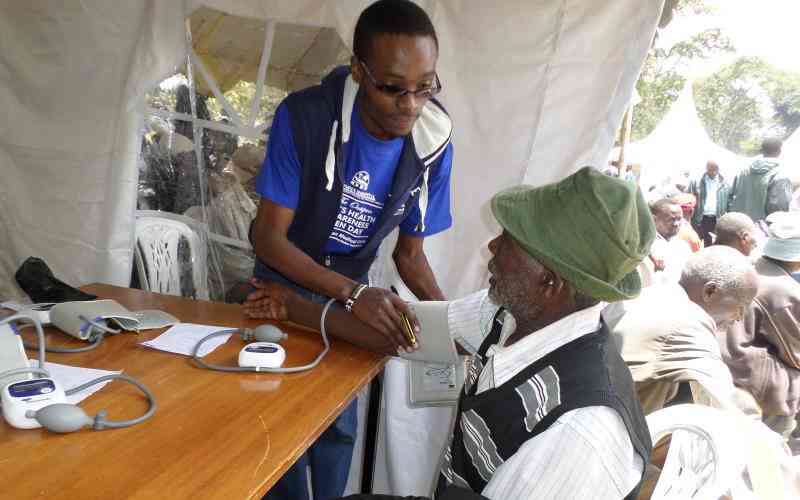
The HIV pandemic in Kenya, which reached alarming levels in the 1990s, has evolved significantly over the past few decades.
Once regarded as a crisis, Kenya has made significant strides in combating the disease, reducing new infections by 53 per cent since 2010 and cutting AIDS-related deaths by over 60 per cent.
However, despite these achievements, recent studies by the National AIDS and STI Control Programme (NASCOP) have uncovered an unsettling trend: the HIV epidemic is increasingly affecting older men and young women.
In the early 2000s, HIV/AIDS in Kenya was widely recognised as a severe public health threat, with devastating impacts on families, communities, and the economy. By the mid-1990s, approximately 10.5 per cent of Kenyans were living with HIV.
This figure halved to 5.9 per cent by 2015, thanks to aggressive public health interventions - including the introduction of Anti-Retroviral Therapy (ART) and preventive measures such as Voluntary Medical Male Circumcision (VMMC).
In 2018, Kenya had 1.6 million people living with HIV. Although the infection rate has declined, new infections remain alarmingly high, particularly among specific age groups. The spread of HIV is majorly driven by sexual transmission, with most cases occurring through unprotected heterosexual sex.
A report by the Kenya Demographic and Health Survey (KDHS) revealed that while the general population has seen a reduction in HIV prevalence, young women, adolescents, and men in age-disparate relationships have seen an uptick in new infections.
- HIV self-testing uptake soars among Kenyan men
Keep Reading
Cultural expectations
These relationships, in which older men engage in sexual activities with younger women, are more likely to be unprotected, leading to a higher transmission risk for the younger partner. One key factor is that older men are often less likely to use condoms, owing to the belief that they are less likely to contract HIV.
Additionally, younger women may feel pressured to engage in sex with older men due to socio-economic factors, such as financial dependence or cultural expectations.
The NASCOP studies suggest that older men, who are often in their 40s or 50s, may not only have more sexual partners, but are also less likely to undergo HIV testing or seek treatment, thereby unknowingly spreading the virus.
This age-disparate relationship dynamic is a critical factor contributing to the rising infection rates among young women. Data from KDHS highlights that young women in urban areas, such as Nairobi and Mombasa, are at high risk due to the prevalence of older, wealthy men seeking younger sexual partners. Age-mixing patterns—referring to the sexual relationships between people of significantly different ages—play a crucial role in HIV transmission dynamics.
Older men, especially those with multiple sexual partners, tend to have higher viral loads if they are HIV-positive, which increases the likelihood of transmission to younger women. Additionally, older men may not feel the urgency to get tested or use protective measures, further exacerbating the spread of the virus.
Bargaining power
Moreover, economic and social pressures, including transactional sex, further compound this risk. Young women in Kenya, particularly in rural and urban informal settlements, are sometimes economically dependent on older men. This dependency increases their vulnerability to sexual coercion and lowers their ability to negotiate safe sex practices.
While new infections among young women and older men are of growing concern, another important issue is the transmission of HIV from mother to child.
According to the KDHS, although significant progress has been made in preventing this transmission, about 6,500 babies were born with HIV in 2018 alone. This remains a major public health challenge.
The KDHS data also shows that HIV prevalence among married women remains higher than among single women. Married women often have limited bargaining power when it comes to condom use, leading to a higher risk of infection.
Adolescents are also at an increased risk of HIV. The 2018 KDHS reports that approximately 75,000 adolescents aged 10-19 are living with HIV. This age group is especially vulnerable due to a lack of access to HIV-related education services, and stigma surrounding the disease.
Kenya’s response to the HIV epidemic has yielded remarkable results. As of 2018, 69 per cent of adults living with HIV were receiving ART, and more than half of them were virally suppressed. However, the coverage for children under 15 remains lower, at 61 per cent, and access to HIV prevention services for young women and other at-risk groups needs further expansion.
Kenya has also been a pioneer in providing HIV pre-exposure prophylaxis (PrEP) and has made great strides in scaling up HIV testing and treatment. Despite these advances, key populations—such as men who have sex with men, sex workers, and people who inject drugs—remain disproportionately affected by HIV, contributing to the ongoing burden of the epidemic.
Reducing stigma remains one of the biggest barriers to effective HIV prevention and treatment. Many people living with HIV still face discrimination, which discourages them from seeking testing and treatment services.
 The Standard Group Plc is a multi-media organization with investments in media platforms spanning newspaper print
operations, television, radio broadcasting, digital and online services. The Standard Group is recognized as a
leading multi-media house in Kenya with a key influence in matters of national and international interest.
The Standard Group Plc is a multi-media organization with investments in media platforms spanning newspaper print
operations, television, radio broadcasting, digital and online services. The Standard Group is recognized as a
leading multi-media house in Kenya with a key influence in matters of national and international interest.











